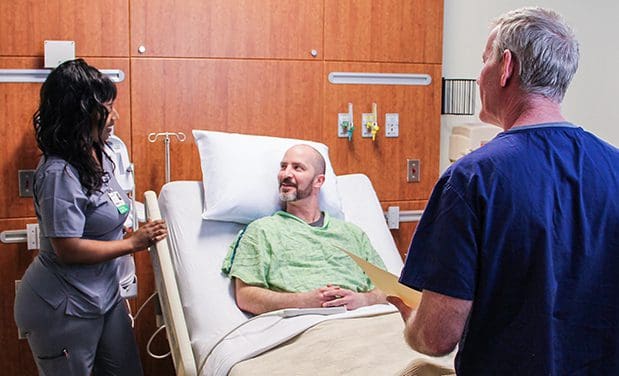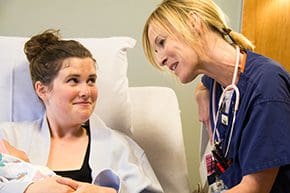Nursing’s Role in Quality & Patient Outcomes

Memorial Hospital Belleville and Memorial Hospital Shiloh are committed to continuous improvement of the delivery, quality, efficiency, and outcomes of nursing practice.
In their roles as leaders and partners in improvement initiatives, our nurses use the latest evidence-based practices to guide their decision making. They challenge themselves to assess the impact of their practice on patients, colleagues, the profession, and the organization. Our Professional Governance structure remains the driving force behind exceptional nursing care and provides the support for improved quality outcomes. This continuous improvement is accomplished by collecting data, performing a review and analysis of that data, and using the newly developed knowledge for informed decision making, evaluation, and implementation of process improvement activities to ultimately create a positive impact on our patient outcomes.
The National Database for Nursing Quality Indicators (NDNQI) remains the comparative external benchmark for nursing services. More than 2,000 hospitals across the nation participate in this quality database that provides the ability to examine relationships between nursing care and patient outcomes. A nurse sensitive indicator (NSI) represents a nursing practice that directly contributes to patient care. The NSIs are monitored routinely throughout inpatient, outpatient, rehabilitation, and support service environments to identify opportunities for improvement. Each area where nursing care is provided, NSIs are selected based on their patient population, a quality improvement action plan is established, and results are shared through various avenues.
Unit-specific patient outcomes are reported to NDNQI quarterly with returned benchmarked data for the following NSIs: Falls and Falls with Injury, Hospital Acquired Pressure Injuries (HAPI), Restraint Use, Catheter Associated Urinary Tract Infections (CAUTI), Central Line Associated Blood Stream Infections (CLABSI), and Ventilator Associated Events (VAE). In 2020, we also began collecting data on the following NSI’s: Surgical Burns, Surgical Errors, and Unplanned Postoperative Admissions. To outperform, a unit must be better than the benchmark (below the benchmark for the NSI) for the majority of the quarters (greater than 4 out of the past 8 quarters). Both campuses perform well within the comparative benchmarks for their NSI’s.
Catheter Associated Urinary Tract Infection (CAUTI)
Sustained efforts to prevent CAUTI have shown positive results. Memorial takes initiative to decreasing the use of indwelling urinary catheters as it is imperative in decreasing infections. The nursing focus remains on early removal of an indwelling urinary catheter along with evidence-based catheter care. In the event a CAUTI occurs, the department Unit Leadership Team (ULT) in conjunction with the Infection Prevention Specialist will conduct an analysis of the circumstances surrounding the infection to help identify areas of opportunity. If necessary, additional education or process improvement plans are implemented to help close any gaps that are noted.
Central Line Associated Blood Stream Infections (CLABSI)
Central venous catheters (CVC) are often essential in the care of the critically ill patient. They allow safe administration of intravenous medications that cannot be given peripherally, aid in the administration of intravenous fluid resuscitation, and help in monitoring hemodynamic parameters in the management of patients with syndromes such as septic shock, cardiogenic shock, decompensated heart failure, and pulmonary hypertension. Despite the benefits of CVCs, they also serve as potential portals for localized and systemic bloodstream infections. For this reason, considerable effort has gone into reducing the incidence of bloodstream infections from CVCs at Memorial. In the event a CLABSI occurs, the department ULT in conjunction with the Infection Prevention Specialist will conduct an analysis of the circumstances surrounding the infection to help identify areas of opportunity.
Falls
The focus on the prevention of patient falls remains a top priority for each nursing unit and the entire Nursing Services department. We are constantly eliminating hazards that could play a part in a patient’s fall. Our attention to details and our use of appropriate resources have resulted in a lower number of avoidable falls with injury over time. A rigorous post-fall process is in place, with an immediate Post-Fall Huddle with the staff involved then an analysis of a post-fall documentation tool by the department ULT to identify any opportunities for improvement. When possible, involved staff are invited to join the ULT conversation surrounding the fall event. This practice has been able to shed light into the true cause of the falls and get staff actively involved in the process.
On a monthly basis, a thorough review of all patient falls is completed by the Quality Improvement department. This information is then distributed to our Nursing Leadership and Quality Specialists, bedside staff who lead quality initiatives within their department. Trends are identified and acted upon, along with recognition for units with sustained improvement. This aggregate data is also reviewed with our Quality and Nurse Practice Council (QNPC) to further identify opportunities for improvement.
Hospital Acquired Pressure Injuries (HAPI)
Much like fall prevention, preventing patient harm from hospital acquired pressure injuries continues to be at the forefront of each inpatient nursing unit. Risks for developing pressure injuries include advanced age, immobility, incontinence, inadequate nutrition/hydration, device related skin pressure, multiple comorbidities, and circulatory abnormalities. Memorial has implemented a variety of tools to decrease the incidence of HAPI’s, which include:
- Pressure relief mattresses
- Nurses completing a Braden risk assessment tool for patients daily
- Monitoring patients’ food/fluid intake
- Excellent skin care for incontinent patients
- Rotating devices to minimize pressure/friction
- Turn and repositioning schedules
Evolving Quality Improvement
Memorial Hospital recognizes that quality improvement is a key factor in enhancing safety, effectiveness, and efficiency in healthcare which ultimately produces better outcomes for our patients. The Quality Improvement department at Memorial has been working diligently to make changes in our approach to quality and patient safety. We are undergoing a structural change, which is bringing various groups of individuals together that were once separated, creating better communication lines, a sense of partnership, and streamlining our processes as a team.
Enlarging the department has allowed us to set focus on creating collaborative workgroups with set priorities on harm prevention. Biweekly meetings on surgical site infections (SSIs) is one example that has opened communication lines between departments and has allowed us to discover opportunities with pre and post-surgical patient care, evaluate new products, and develop education for our bedside staff.
Our Medication Safety Review Team is another multidisciplinary group that meets weekly to review all the medication errors that occur throughout all three facilities. We can identify gaps in care and quickly react with staff education and process improvement plans to mitigate an error from occurring again. We have strong engagement from multiple Pharmacists, who provide much of the education to our bedside nursing staff on subjects such as insulin administration and the home medication reconciliation process. Each week, we develop strategies to prevent further errors from arising.
At Memorial Hospital, our leadership is committed to providing solutions and resources that enable us to continuously improve the quality of health care we deliver. They understand quality improvement involves people as part of the improvement solution and encompasses the employees that best understand the processes. While we are at the beginning stages of our new journey, we are making great strides in identifying areas of opportunity and taking the appropriate steps to focus on preventing patient harm.
In This Section
- Overview
- A Message from the Vice President of Patient Care Services/Chief Nursing Officer (CNO)
- Nursing Mission and Vision Statements
- Magnet Recognition
- Nursing by the Numbers
- Professional Practice Model
- Nursing Professional Governance
- RN Residency Program
- Nursing Awards and Recognition
- Research and Evidence-Based Practice
- Quality and Patient Outcomes
- Nurse Well-Being
- Community Outreach by Nursing Professionals
- Nursing Jobs


